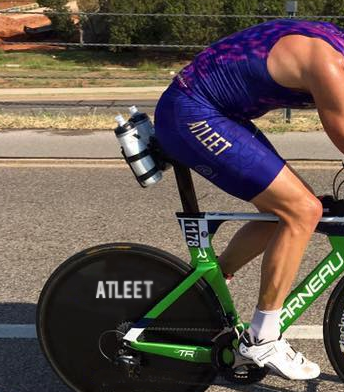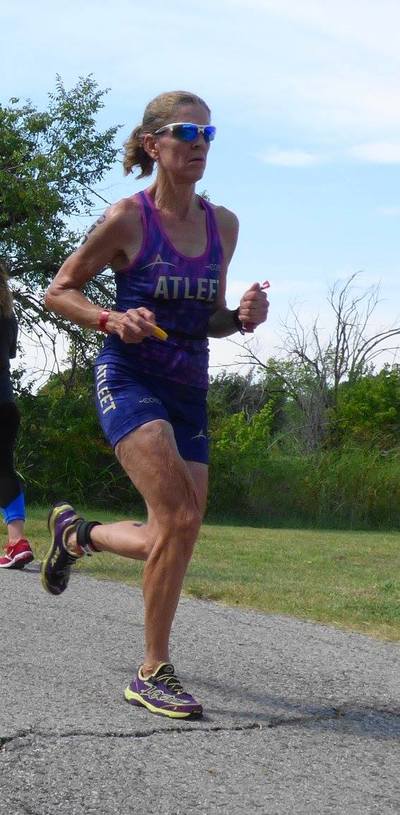|
One of the key foundations of a great freestyle stroke is good exhalation. You might have been previously taught to hold your breath to increase your buoyancy. While this can increase your upper body buoyancy, it causes the legs to sink resulting in drag. Holding your breath also makes swimming feel harder as your body stores carbon dioxide, making you feel ‘out of breath.’
The ability to exhale comfortably in the water enables you to feel relaxed and develop a rhythm so that you can swim continuously without needing to stop at the end of every lap. Try this next time you swim. As you swim freestyle repeat the mantra with each stroke: Bubble-bubble-breathe; One, Two, Breathe; or even Exhale, Exhale, Breathe. Say “Bubble” into the water to help remind you to breathe out constantly for two arm pulls. On the third stroke say, “breathe” in your mind's eye as you rotate and take a breath. These mantras help you coordinate exhalation and bilateral breath timing in a three-stroke cycle. Focus on exhaling by contracting your stomach muscles as you push air out. Inhale by relaxing your diaphragm.
0 Comments
 What happens to your endurance fitness if you take an extended break from training? I’m going to explain the timeline showing what changes in fitness you can expect when you stop training for six months. According to the fitness mantra, you either have to ‘use it or lose it’! It might be a bit of a cliché, but it turns out that this saying perfectly sums up one of the key principles of fitness – reversibility. So long as you train, you can maintain and (hopefully) build your fitness levels. However, stop training, and your fitness levels will steadily decline. The obvious question that you might ask therefore is: ‘how much fitness will I lose if I decide to take a break or I’m forced to stop training because of injury, illness or other circumstances? And how rapidly will this fitness loss occur?’ Components of fitness So let’s take an imaginary well-trained athlete and observe what happens to his or her body over a period of six months following the complete cessation of training. Let’s assume that all training STOPS on September 16th- after Redman Triathlon in Oklahoma City. Sept 16 This is your last training day/Race for six months. After today, you store your bike away, hang up your shoes and join the bulk of folk who do no regular vigorous exercise whatsoever! Sept 20: After three days of inactivity, you might expect that your fitness has already begun to decline. In reality however, the losses at this stage are very minimal. In fact, if you had been training hard prior to day zero, after three days of rest, your fitness is now probably enhanced! That’s because in those three days, your muscles have had time to fully recover; muscle carbohydrate stores (glycogen) have been topped off, muscle fibers damaged during hard training have been fully repaired and favorable metabolic changes in the muscles have had time to occur. Indeed, this peak in performance after a few days of rest is exactly the reason why tapering works and why you shouldn’t train right up to the day of a big event. Sept 23: After a week of inactivity, changes begin to occur in the body that result in fitness losses. For example, after three days, your blood volume can be reduced by 5-12%. This means a decrease in amount of blood your heart can pump – both in terms of amount of blood pumped per beat and total blood volume per minute. The result is that your heart has to work slightly harder to maintain a given workload on the bike. There are some metabolic changes too; after six days or so, muscles begin to become less efficient at ‘soaking up’ glucose (the body’s premium fuel for exercise) from the bloodstream. This means that during exercise, you need to place more reliance on your (limited) muscle glycogen stores and also that you become less efficient at building up those glycogen stores after exercise. A third change is that your muscles start to become less efficient at coping with lactate accumulation during sustained efforts hard exercise. The consequence is that you won’t be able to sustain quite the same exercise intensity! Oct 3: At this point, your maximal oxygen uptake (VO2max – the prime measure of your aerobic fitness) will have declined by anything from 4-20%. Part of this stems from reduced cardiac output – not helped by the fact that the muscle mass in the pumping chambers of the heart can decrease by almost 20% after three weeks of inactivity! Oct 16: All of the detraining changes outlined above continue to progress but fundamental muscle changes are now becoming prominent. By now, your muscle capillarization will have returned to your pre-training baseline (however it’s still likely to be higher than that in people who have never trained). In addition, alterations are taking place in your muscle biochemistry. In particular, the biochemical pathways that help your muscles burn fat for energy start to become less efficient, making it harder to burn fat while you ride, which in turn reduces your endurance capacity. On top of that, your ability to maintain a full-out effort (for example, a sprint to the finish line) diminishes dramatically. Dec 1: After two months of inactivity, your heart is noticeably less muscular, with the thickness of the muscle walls that comprise the pumping chambers reduced by as much as 25%. The muscle mitochondria are also becoming less efficient at using oxygen to produce energy in your muscles. This efficiency can decline by 25-45% up to twelve weeks after training cessation. After three months, you also begin to undergo hormonal detraining. Hormones are chemical messengers that regulate the body’s biochemistry; as you become detrained, more stress hormones are released during exercise, which basically means that the same exercise intensity becomes more stressful for the body, which in turn increases recovery times. Feb 19: By six months, your fitness declines have mostly stabilized. However, there are still undesirable changes taking place. For example, the actual volume of mitochondria per unit volume of muscle is declining, further reducing your ability to utilize oxygen during exercise. In addition, while you’ve lost muscle mass, you’ve almost certainly gained body fat due to a lower daily calorie burn and reduced muscle mass. So while you may not have gained weight on the scales, you will have almost certainly become ‘fatter’, with all the health risks that involves. Look for our next blog post for Part II: Ways to maintain your fitness in the off season. Record-breaking wind. Waves taller than athletes. Over 90 degree heat with high humidity. Talk of the anticipated weather conditions was the number one topic discussed around athletes the week of the race. It was easy to get caught up in the hearsay and let fear and anxiety creep in. This is the pep talk Dan offered his athletes a few days before to help them mentally prepare.
You wouldn't be in this sport or any sport that competes with the weather if you didn't have a strong will, body or both. You've worked on the body for months even years to overcome such feats of endurance. You know you are going to finish, so let us nail that point on the wall. Let's talk to the Monkey. In psychiatry, this is the limbic system or the small brain. The part of the brain that screams "we are all going to die." It's a necessary function that rears its ugly head when trying to focus on your race. You want to concentrate on the Frontal Cortex. The logical brain. Now don't overthink this which is easy to do. Take a deep breath, and let's go over what you already know. SWIM: The Anticipation of Big Waves Stroke Rate: Increase your stroke rate. Example, my average race stroke rate is around 68-72spm. Face with big waves or lots of short choppy waves I will intermittently increase to 75-80spm. Think of a song or a rhythm that will help you. Or sing a familiar song a little faster. Wide PULL: It's common in the pool to have the hands right under the shoulder as you pull the water. Try moving your hands a little wider to stabilize your balance. High Swells: This can hinder sighting. Try switching to a breaststroke for a few strokes. When your body reaches the top of the swell, the head will be steady, stable and your head will be high enough to see clearer. Don't worry out losing speed. For some, you won't lose a beat. BIKE: For a lot of people, this as the recovery between the swim and run. Try and manage your nutrition. Stay as relaxed as possible. If you're feeling rigid, have the monkey do a system-wide check. Hands relaxed, elbows resting comfortably, feet turning over the paddles smooth and relaxed. No mashing. Tension burns calories and tires the mind. Most accidents occur when this happens. 5-10 miles left quick body check and formulate a plan for the run. Give that Frontal lobe something to do. RUN TIME: Evaluate, Evaluate, Evaluate. In the heat, I try to do negative splits. We all want to finish like Mark Allen or Paula-Newby Fraser, but it's not going to happen if you chase those rabbits too soon. Get in a lap then check your reserves, do you have what it takes to push the pace a little faster, how are you feeling. Are you managing your body temperature? The two I like are ice under my hat (yes I wear a hat on hot days just for that reason) and ice in the mouth under the tongue. Protect the brain from the heat first, then move to cool or cold water on the spine. Drink cold fluids, stuff sponges under your shirt. The takeaway? KNOW what you want to do. EXECUTE your plan. ADJUST were needed. LOOK forward to seeing what can happen and prepare for it. IF and IF it arrives you will be READY. |
ATLEETSWe are a community, a family, all supporting one another on our personal journeys to reach greater heights. Our group doesn’t change who you are, it reveals who you are. Archives
February 2018
Categories |
© ATLEET Fitness, All Rights Reserved






 RSS Feed
RSS Feed